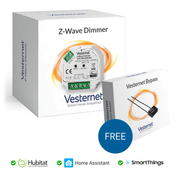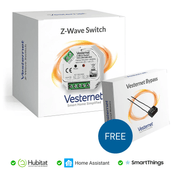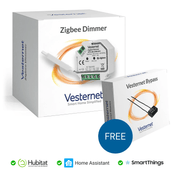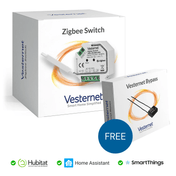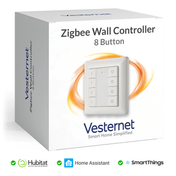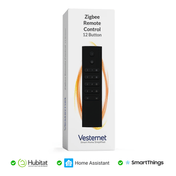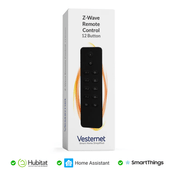Smart RGB lighting has become essential for creating personalised home atmospheres, but choosing between controller-based systems and all-in-one strip solutions can be overwhelming with so many technical considerations. Whether you're upgrading existing strips or starting fresh with rgbw individually addressable lighting, the decision between a dedicated led strip wireless controller and an integrated solution impacts everything from installation complexity to long-term expandability.
This comparison will help you decide whether the Fibaro's controller approach or Aqara's integrated strip solution better matches your smart home setup, DIY preferences, and lighting automation goals. As a specialist smart home retailer, Vesternet has extensive experience with both Z-Wave and Zigbee lighting systems, giving us unique insight into real-world performance and compatibility considerations.

Understanding the Fibaro RGBW Controller 2 System
The Fibaro RGBW Controller 2 operates as a sophisticated hub for existing RGBW LED strips, transforming basic lighting into intelligent, colour-changing installations. This Z-Wave Plus device connects between your power supply and LED strips, acting as the brain that interprets wireless commands and translates them into precise colour and brightness adjustments.
System Components and Requirements
- Fibaro RGBW Controller 2 module (the wireless control unit)
- Compatible RGBW LED strip (purchased separately)
- 24V DC power supply (matched to strip requirements)
- Z-Wave gateway or hub for network connectivity
The controller's strength lies in its flexibility—it works with virtually any 12V or 24V RGBW strip, making it perfect for upgrading existing installations. Its Z-Wave Plus connectivity ensures reliable mesh networking, whilst supporting advanced features like scene control and integration with home assistant rgbw automation systems.

Inside the Aqara LED Strip T1 All-in-One Solution
The Aqara LED Strip T1 represents a completely different approach, combining the led strip controller zigbee functionality directly into the strip itself. This eliminates the need for separate controller hardware, creating a plug-and-play solution that's immediately ready for smart home integration.
Integrated Features and Connectivity
- Built-in Zigbee 3.0 wireless controller within the strip
- Matter-over-bridge compatibility for universal ecosystem support
- Individual segment control across ten distinct zones
- IP44 outdoor rating for weather resistance
This led strip wireless controller approach means fewer components to install and configure. The Zigbee 3.0 protocol provides mesh networking benefits whilst Matter support ensures future-proofing across multiple smart home platforms, from Apple HomeKit to Google Assistant and beyond.
Controller vs Integrated Strip: Architecture and Installation Differences
The fundamental difference between these approaches shapes every aspect of your lighting installation. The Fibaro system separates the wireless intelligence from the light source, whilst the Aqara integrates everything into a single unit.

Installation Complexity Comparison
- Fibaro requires mounting a separate controller module in an accessible location
- Aqara needs only power connection and hub pairing
- Controller systems offer more flexible mounting options for the wireless components
- Integrated strips simplify cable management but limit controller placement
Protocol support creates another key distinction. The Fibaro leverages Z-Wave's 868MHz frequency, known for excellent range and mesh reliability, particularly beneficial for home assistant rgbw installations. Z-Wave's lower device density per network ensures consistent performance even in busy RF environments.
Conversely, the Aqara's Zigbee 3.0 operates on the 2.4GHz band, sharing spectrum with Wi-Fi but offering broader device compatibility. Zigbee's mesh topology allows each device to act as a repeater, potentially creating more robust networks in larger homes.
Expandability and Flexibility Considerations
- Controller systems allow strip upgrades without replacing wireless components
- Integrated solutions require complete replacement if strips fail
- Fibaro supports mixing different strip types on separate controllers
- Aqara offers segment-level control but limits overall strip customisation
Real-World Responsiveness and Automation Performance
Response times and reliability differ significantly between these approaches, influenced by their underlying wireless protocols and system architecture. Z-Wave networks typically deliver consistent 100-200ms response times, whilst Zigbee performance varies more widely depending on mesh density and interference.
Automation Integration Performance
- Z-Wave systems excel in time-critical automation scenarios
- Zigbee offers broader ecosystem compatibility but variable latency
- Matter support provides future-proofing but adds protocol overhead
- Local processing capabilities differ between dedicated controllers and integrated solutions
The Fibaro's dedicated processing power enables complex colour calculations and smooth transitions without network dependency. This proves particularly valuable for rgbw individually addressable applications where precise timing matters. Meanwhile, the Aqara's integrated approach relies more heavily on hub processing, potentially introducing minor delays during complex colour sequences.
For home assistant rgbw implementations, the Fibaro's Z-Wave integration often provides more reliable automation triggers, whilst the Aqara's Matter compatibility offers broader platform support. Both handle basic on/off and colour changes effectively, but the Fibaro generally delivers superior performance for rapid colour cycling and complex scene transitions.
Fibaro RGBW Controller 2: Strengths and Limitations
The Fibaro controller excels in scenarios requiring maximum flexibility and compatibility with existing installations. Its ability to work with virtually any RGBW strip makes it ideal for upgrading traditional lighting or integrating with custom installations.
Key Advantages
- Universal RGBW strip compatibility eliminates vendor lock-in
- Separate controller placement allows optimal wireless positioning
- Z-Wave mesh reliability ensures consistent automation performance
- Independent component replacement reduces long-term costs
However, the multi-component approach introduces complexity that some users find challenging. Installation requires careful planning for controller placement, power supply sizing, and cable routing. The need for a separate Z-Wave hub adds another layer of system dependency, though this often proves beneficial for users with existing Z-Wave networks.
Potential Drawbacks
- Higher initial setup complexity with multiple components
- Requires Z-Wave hub for connectivity
- Controller mounting location constraints in some installations
Aqara LED Strip T1: Benefits and Drawbacks Breakdown
The Aqara's integrated approach shines for users prioritising simplicity and modern connectivity options. Its plug-and-play nature makes it particularly attractive for DIY enthusiasts and those new to smart lighting.
Standout Features
- Individual segment control enables sophisticated lighting patterns
- Built-in music sync responds to audio without additional hardware
- IP44 rating supports outdoor installations
- Matter compatibility ensures broad ecosystem support
The strip's rgbw individually addressable segments allow for gradient effects and zone-specific control that would require multiple controllers in traditional systems. This capability, combined with its DIY-friendly cuttable design, makes it excellent for creative installations.
Notable Limitations
- Strip failure requires complete unit replacement
- Limited to Aqara's specific strip specifications
- Zigbee network performance varies with environmental factors
Matching RGB Solutions to Your Smart Home Setup
Your existing smart home infrastructure heavily influences which approach suits your needs. Users with established Z-Wave networks gain immediate compatibility benefits from the Fibaro controller, whilst those building new systems might prefer the Aqara's modern protocol support.

Choose the Fibaro RGBW Controller 2 If You:
- Already own quality RGBW strips worth preserving
- Operate an existing Z-Wave smart home network
- Need maximum installation flexibility and component independence
- Prioritise proven mesh reliability for home assistant rgbw automation
The controller approach particularly suits professionals and serious enthusiasts who value system flexibility over simplicity. Its ability to work with various strip types makes it ideal for complex installations or situations where specific strip characteristics matter more than integrated convenience.
Choose the Aqara LED Strip T1 If You:
- Want plug-and-play installation simplicity
- Need outdoor-rated lighting solutions
- Value individual segment control and gradient effects
- Prefer Matter-compatible, future-proof connectivity
This integrated led strip controller zigbee solution excels for users starting fresh or those prioritising modern features like music synchronisation and app-free voice control. Its Zigbee 3.0 connectivity suits homes using Aqara hubs or universal platforms supporting multiple protocols.
Consider your long-term plans carefully. If you anticipate expanding your lighting installation or mixing different strip types, the Fibaro's modular approach offers significant advantages. However, if you want immediate results with minimal technical complexity, the Aqara delivers sophisticated lighting effects in a user-friendly package.
Making Your RGB Lighting Decision
Both the Fibaro RGBW Controller 2 and Aqara LED Strip T1 excel in different scenarios, making the 'better' choice entirely dependent on your specific smart home setup and preferences. The Fibaro controller offers superior flexibility for those with existing RGBW strips or established Z-Wave networks, whilst the Aqara provides an all-in-one solution perfect for new installations and DIY projects.
Consider the Fibaro if you already have quality RGBW strips, prefer Z-Wave's proven mesh reliability, or want the flexibility to upgrade components independently. Choose the Aqara if you're starting fresh, value Matter compatibility, need outdoor-rated lighting, or want advanced features like individual segment control and music synchronisation without additional components.
The key factors to weigh are your existing smart home protocol, whether you have strips to repurpose, your comfort level with multi-component setups, and your long-term expansion plans. Both solutions deliver excellent colour accuracy and automation capabilities—the decision comes down to whether you prioritise system flexibility or integrated convenience. Browse both options to see which approach aligns better with your smart lighting vision.










